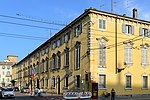Sanctuary of Santa Maria della Steccata
1539 establishments in Italy16th-century Roman Catholic church buildings in ItalyBasilica churches in Emilia-RomagnaBurial sites of the House of Bourbon-ParmaBurial sites of the House of Farnese ... and 6 more
Burials at the Sanctuary of Santa Maria della SteccataChurch buildings with domesPaintings by ParmigianinoRenaissance architecture in ParmaRoman Catholic churches completed in 1539Roman Catholic churches in Parma

The Shrine of Santa Maria della Steccata is a Greek-cross design Renaissance church in central Parma, Italy. The name derives from the fence or steccato used to corral the numerous devotees who visited a venerated image of the Madonna. A Nursing Madonna is enshrined was crowned on 27 May 1601 by a Marian fanatic and devotee, Fray Giacomo di Forli of the Capuchin order. Pope Benedict XVI issued a Pontifical decree which raised the Marian sanctuary to the status of Basilica on 9 February 2008.
Excerpt from the Wikipedia article Sanctuary of Santa Maria della Steccata (License: CC BY-SA 3.0, Authors, Images).Sanctuary of Santa Maria della Steccata
Via Dante Alighieri, Parma Parma Centro
Geographical coordinates (GPS) Address Nearby Places Show on map
Geographical coordinates (GPS)
| Latitude | Longitude |
|---|---|
| N 44.8025 ° | E 10.3275 ° |
Address
Museo Costantiniano della Steccata
Via Dante Alighieri
43121 Parma, Parma Centro
Emilia-Romagna, Italy
Open on Google Maps











